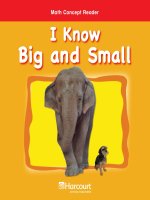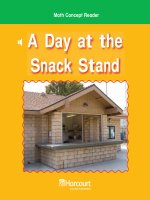Math Concept Reader MCR g4 fighting fire with fire
Bạn đang xem bản rút gọn của tài liệu. Xem và tải ngay bản đầy đủ của tài liệu tại đây (7.47 MB, 19 trang )
Math Concept Reader
&IGHTING
&IREWITH&IRE
Expedition:
Antarctica
by Aenea Mickelsen
ca62xs_lay_061207ad_am.indd 4 1/9/07 9:09:15 AM
DIGITAL FINAL PROOF
Copyright © Gareth Stevens, Inc. All rights reserved.
Developed for Harcourt, Inc., by Gareth Stevens, Inc. This edition published by Harcourt, Inc., by
agreement with Gareth Stevens, Inc. No part of this publication may be reproduced or transmitted
in any form or by any means, electronic or mechanical, including photocopy, recording, or any
information storage and retrieval system, without permission in writing from the copyright holder.
Requests for permission to make copies of any part of the work should be addressed to Permissions
Department, Gareth Stevens, Inc., 330 West Olive Street, Suite 100, Milwaukee, Wisconsin 53212.
Fax: 414-332-3567.
HARCOUR
T and the Harcourt Logo are trademarks of Harcourt, Inc., registered in the United States
of America and/or other jurisdictions.
Printed in the United States of America
ISBN 13: 978-0-15-360194-1
ISBN 10: 0-15-360194-9
1 2 3 4 5 6 7 8 9 10 179 16 15 14 13 12 11 10 09 08 07
by Sarah Mastrianni
Fighting
Fire with Fire
Math Concept Reader
ca48os_lay_070107af_ll.indd 3 1/7/07 8:20:26 PM
DIGITAL FINAL PROOF
Rocky Mountain Lodgepole Pines are amazing
trees. They are tall and very thin. They grow in many
different environments, from wet bogs to dry soil.
Long ago, local Native American tribes stripped the
bark from Lodgepole Pines to use it for medicine and
to bake bread. Today, people use this pine to make
furniture and fence posts, among other things.
This tree has one more amazing quality, though.
The seeds within the pinecone of a Rocky Mountain
Lodgepole Pine are only released in extremely hot
temperatures.
In fact, the temperatures must reach between 113
and 120 degrees Fahrenheit. In most places, only fire
can create temperatures this hot.
2
Chapter 1:
Fire: A Necessary
Part of Life
ca48os_lay_070107af_ll.indd 2 1/7/07 8:20:33 PM
DIGITAL FINAL PROOF
Fire has many benefits. It can create
new growth. New growth provides food for forest animals.
Deer eat the grass that grows after a fire. Fire can create
shelter for wildlife. Some insects lay eggs in burned trees.
Burning the leaves and plants that shade the ground opens
the forest up to sunlight. This improves chances for new
plant growth.
Certain fires, called
pr
escribed fires or controlled
burns, help prevent the spread of wildfires by naturally
thinning out the overcrowded forest and reducing the
fire fuel build-up. Dead wood, unhealthy trees, and
thick layers of pine needles provide fuel for fires. Native
Americans were some of the first people to use
pr
escribed
fires.
3
Rocky Mountain Lodgepole Pine trees
need the very high heat of fire to release
seeds from their pinecones.
ca48os_lay_070107af_ll.indd 3 1/7/07 8:20:46 PM
DIGITAL FINAL PROOF
Natural causes can ignite a fire. A set fire is planned
and monitored by burn bosses in charge of the fire. The
main responsibility of a burn boss is to determine the
section of land to be burned and carefully figuring out
the perimeter of a planned burn.
Perimeter has more than one meaning to a burn boss.
Perimeter may mean the boundary, or edge, of a fire. It
also may mean the actual distance around the fire.
It is important for a burn boss to figure out the
perimeter of a controlled burn in order to keep the fire
under control.
4
A burn boss talks to his crew of firefighters about a prescribed fire.
ca48os_lay_070107af_ll.indd 4 1/7/07 8:20:51 PM
DIGITAL FINAL PROOF
It is not an easy job to be in charge of a prescribed
fire. Burn bosses undergo extensive training. A burn boss
must understand fire safety. To do the job well, a burn
boss must use maps and computer programs. Setting the
fire properly takes training, too.
Burn bosses must know the exact location of the spot
to burn. The boss considers factors such as temperature,
wind direction, and moisture in the air, among many
other things. The fire must be hot enough to burn debris,
but it cannot be so hot that it destroys big trees or certain
animal habitats. A prescribed fire requires trained crew
members as well as many different tools.
5
Burn bosses use maps to help decide exactly what area to burn.
ca48os_lay_070107af_ll.indd 5 1/7/07 8:20:56 PM
DIGITAL FINAL PROOF
People use maps to plan a prescribed fire. Maps
show exact locations and let people “see” what is in the
burn region. It is important for crew members of a burn
to know the features of the land to be burned.
A burn boss often calls in wildlife experts to help
plan a burn. They look at the map of a burn location.
They decide whether or not the fire will hurt any animal
habitats.
Maps
also
help determine where to hammer repeaters
into the ground. Repeaters are radio towers that share
information around the burn. Finally, maps can show the
perimeter of a burn. Perimeter is calculated by adding
the lengths of the sides of the section to be burned.
6
Chapter 2:
Mapping the Fire
ca48os_lay_070107af_ll.indd 6 1/7/07 8:20:56 PM
DIGITAL FINAL PROOF
2EMEMBERPERIMETERCANHAVETWOMEANINGSWHEN
TALKINGABOUTAPRESCRIBEDlRE3UPPOSEACONTROLLED
BURNISSETINARECTANGULARlGURE4HEPERIMETERREFERS
TOTHEBORDEROFTHERECTANGLEITSELFASWELLASTOTHE
DISTANCEAROUNDTHERECTANGLE
9OUCANlNDTHEPERIMETEROFTHERECTANGULARlGURE
BYUSINGTHISFORMULA
0XLXW
0XX
0
4HEPERIMETEROFTHISBURNISFEET!MAPSHOWS
THELOCATIONOFWHERETHEBURNWILLTAKEPLACE4HIS
INCLUDESALLOFTHETHINGSAROUNDTHEPERIMETERSUCHAS
MOUNTAINSORRIVERS
,
4HEPERIMETEROFTHISRECTANGULARBURNAREAISFEET
/FTENTHEPERIMETEROFABURNISNOTASHAPEWITH
SIDESTHATARETHESAMELENGTH4HEBURNBOSSMAYWALK
THEPERIMETERWITHAWILDLIFEEXPERT4OGETHERTHEYWILL
lNDSPOTSTHATSHOULDNOTBEBURNED4HESPOTSMAY
BEHOMETOANENDANGEREDANIMAL4HEBOSSWILLNOT
INCLUDETHESPOTSINTHEBURNPERIMETER
.OWTHEBURNBOSSRECALCULATESTHEPERIMETER4HE
SIDESMEASUREFEETFEETFEETFEETAND
FEET
0ABCDE
0
0
4HElREPERIMETERISFEET
-
4HESIDESOFTHISBURNAREAARENOTTHESAMELENGTH4HEPERIMETERISFEET
Maps give information to firefighters, such as the
location where a planned burn will take place. They
may discover that the burn section is about 190 feet on
one side, 240 feet on another side, and 85 feet on a third
side.
P = a + b + c
P = 190 + 240 + 85
P = 515
The firefighters need to contain a perimeter of about
515 feet. Knowing the perimeter helps the burn boss
determine the number of firefighters needed to control
the burn. As the perimeter increases, so does the number
of firefighters needed. Maps help firefighters know
exactly where to be during a prescribed fire.
9
Firefighters walk along a trench called a fire line.
100
175
ca48os_lay_070107af_ll.indd 9 1/7/07 8:21:12 PM
DIGITAL FINAL PROOF
Organizing a controlled burn takes careful planning.
The burn itself is hard work, too. The burn boss and
firefighters must be prepared. Every detail is important.
Taking care of all the details helps ensure that the
crew stays safe and the fire remains under control.
One of the first things the burn crew does is dig a
trench. This trench is called a fire line and it is formed by
digging into the soil where there is no fuel to burn.
The trench keeps the fire from spreading and often
forms part, if not all, of the perimeter. A body of water or
a road may also form part of the perimeter.
10
Chapter 3:
From Brown to Green
ca48os_lay_070107af_ll.indd 10 1/7/07 8:21:13 PM
DIGITAL FINAL PROOF
Once a fire line is established, trained professionals
called lighters lay down lines of fire. They keep the fire
lines close together. They create a burn line by keeping
the fire burning within a small portion of the ground.
With fire lines and a burn line formed, crews allow
the fire to grow larger. Fuel, such as dead leaves and
branches, burns as the section of the fire gets larger.
The
lighters
wear protective gear. This includes masks
to prevent them from inhaling too much smoke. It is very
important that everyone who participates in a controlled
burn respect the power of fire. By taking proper safety
precautions, crew members lower their risk of injury.
11
Lighters get equipment ready before laying down fire lines.
ca48os_lay_070107af_ll.indd 11 1/7/07 8:21:16 PM
DIGITAL FINAL PROOF
The prescribed fire crew keeps in constant
communication with one another. This keeps everyone
safe and it also keeps the fire from getting out of control.
A burn boss might position firefighters along the
perimeter of a burn using a Global Positioning System
(GPS). Suppose a burn boss knows that one side of his
burn is about 100 feet long. The second side is about 75
feet long and the third side is about 165 feet long.
P = a + b + c
P = 100 + 75 + 165
P = 340
By adding all the lengths of the sides, the burn boss
knows how and where to position firefighters around a
perimeter of about 340 feet.
12
Crew members communicate information about the fire to each other.
ca48os_lay_070107af_ll.indd 12 1/7/07 8:21:19 PM
DIGITAL FINAL PROOF
The controlled burn crew watches the fire very
carefully. They work around the perimeter, or the
border, of the location being burned and keep a very
close eye on burning embers. They want to make sure
the fire does not cross the fire line. Using maps, they
know exactly where the fire should burn and where it
should not.
The firefighting crew is prepared with many tools,
such as backpacks and water pumps. With these pumps,
crew members quickly extinguish flames that cross
over the perimeter into any part of the forest that is not
in the controlled burn plan. This is just one more way
crew members keep the forest safe while protecting
themselves at the same time.
13
A firefighter uses water to put out embers after the flames die down.
ca48os_lay_070107af_ll.indd 13 1/7/07 8:21:24 PM
DIGITAL FINAL PROOF
The burn is complete. Now the crew begins the
clean up stage, often referred to as mopping up.
Mopping up means that crew members move through
the burn zone to extinguish any remaining smoldering
material.
Sometimes a fire cannot be seen, but that does not
mean it isn’t there. Fire may burn in a tree stump under
the soil and, if left alone, a hot spot such as this could
reignite.
By finding hot spots, firefighters ensure that no
unwanted fire develops. They also ensure that once the
controlled burn is over, it is truly over. An unplanned
wildfire can burn out of control, causing acres of
destruction to plants and wildlife.
14
Crew members mop up and make sure
there are no smoldering hot spots.
ca48os_lay_070107af_ll.indd 14 1/7/07 8:21:30 PM
DIGITAL FINAL PROOF
Within weeks, the burned region will sprout new
growth. The nutrients put back into the soil by the fire
will help grass grow where there had only been dry
debris.
The careful planning on the part of the burn boss and
crew helps prevent the spread of dangerous wildfires.
Everything within the perimeter grows lush and new.
The spread of Rocky Mountain Lodgepole Pine seeds
is only one of many examples of the benefits of fire.
From creating new habitats to encouraging new plant
growth, fire can be a positive force. Like water and
sunlight, fire is necessary for life. Controlled burns, when
well planned and carefully executed, help continue the
life cycle.
15
Everything within the perimeter of a
prescribed fire will grow lush and new again.
ca48os_lay_070107af_ll.indd 15 1/7/07 8:21:36 PM
DIGITAL FINAL PROOF
Glossary
debris the pieces of something that has been
broken up
endangered
to be threatened by extinction
executed carried out according to a plan
extinguish to put out
habitat the place where an animal or plant lives
or grows
perimeter the distance around a figure or a
boundary
pr
ecaution an action that happens in advance
to protect against danger
smoldering to burn without flame, usually
slowly and with a lot of smoke
tr
ench
a long ditch cut in the ground
16
Photo Credits: cover, title page, pp. 3 (both), 5, 14, 15 (both): National
Park Service; pp. 4, 9, 11, 12, 13: U.S. Fish and Wildlife Service
ca48os_lay_070107af_ll.indd 16 1/7/07 8:21:36 PM
DIGITAL FINAL PROOF
4HINKAND2ESPOND
3UPPOSEYOUAREABURNBOSS9OUWANTTOCALCULATETHE
PERIMETEROFAPRESCRIBEDlRE4HESHAPEOFTHEBURN
SECTIONYOUAREPLANNINGISARECTANGLE4HELENGTHSOF
THESIDESOFTHERECTANGLEAREFEETFEET
FEETANDFEET7HATISTHEPERIMETEROFTHElRE
9OUAREINCHARGEOFCREATINGASMALLBURNTOTESTSOME
NEWEQUIPMENT4HEBURNSECTIONISTHEAPPROXIMATE
SHAPEOFATRIANGLE4HELENGTHSOFTHESIDESOFTHE
TRIANGLEAREFEETFEETANDFEET7HATISTHE
PERIMETEROFTHElRE
!SMALLCONTROLLEDBURNHASANIRREGULARSHAPE4HE
LENGTHSOFTHESIDESAREFEETFEETFEET
FEETANDFEET#ALCULATETHEPERIMETER
$RAWAPICTUREOFABURNAREATHATHASARECTANGULAR
SHAPE4HELENGTHSOFTHESIDESOFTHEBURNAREA
AREFEETFEETFEETANDFEET,ABELTHE
DRAWINGWITHTHELENGTHSOFTHESIDESOFTHEPERIMETER
4HENCALCULATETHEPERIMETER%XPLAINHOWYOU
CALCULATEDTHEPERIMETER









